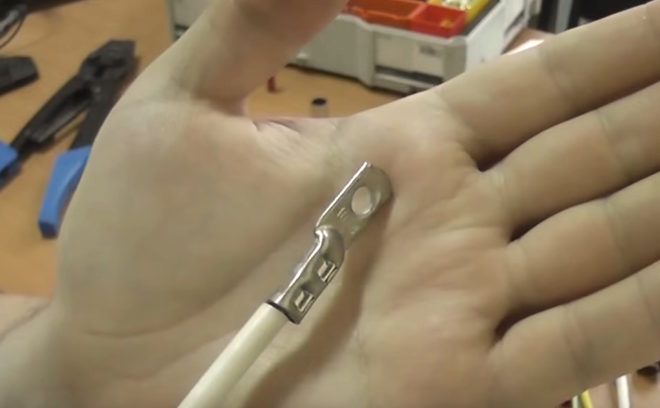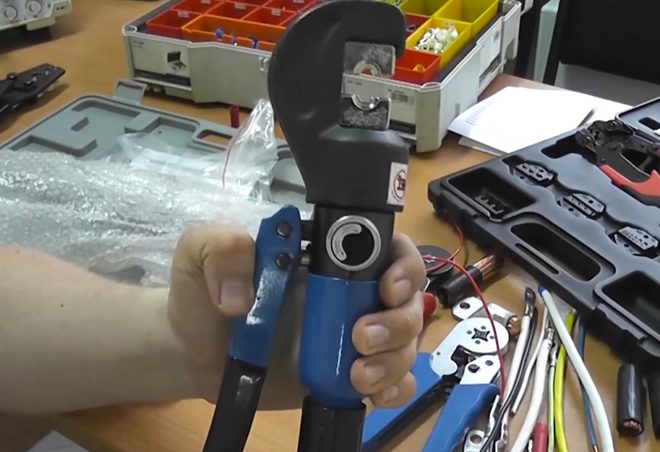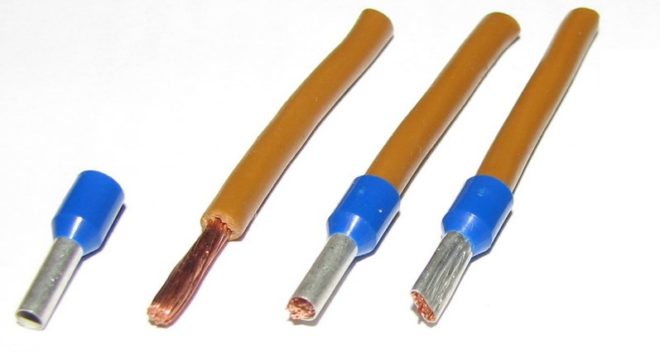Terminals for wires

Very often, when stranded wires are connected to screw terminals, several veins are pinched by a bolt, and mechanical damage can be observed on the whole. All this can cause poor contact, and if the load is large, then fire. To avoid this, it is necessary to use lugs for wires, with their help crimping is performed and a strong contact is created.
Content
A little about transient resistance
In the world of electrical engineering, there are sometimes not very pleasant pictures - melted plastic on a switchboard; burnt or even charred conductors; wires of a multicore cable or wires sticking out in all directions, which careless electricians plant under a common bolt, without using washers. All this suggests that the "specialists" neglected the termination procedure. After all, it is not enough just to bring the cable to the device and connect it. It is necessary to do this in such a way as to minimize the amount of contact resistance and ensure a reliable contact connection.
What is transfer resistance? In essence, it is like a resistor on which a certain amount of heat is released. This value is directly proportional to the current load of the conductor. The more heat is generated, the more likely it is to melt and catch fire.
Therefore, the first priority for any electrical connection is to achieve the minimum value of the transfer resistance. However, this is not always possible for several reasons:
- small contact area;
- metals are covered with an oxide film;
- the crimp is not strong enough.
To minimize these causes and accordingly reduce the contact resistance, it was invented to crimp the wires using ferrules.
Tip types

Now there is a huge variety of them on the electrical goods market - for stranded and single-core wires, for copper and aluminum.
Copper
Stranded copper lugs are a solid-drawn copper tube with one side flattened and a bolt hole. This model has two varieties:
- uncoated (TM);
- tinned (TML).

The marking for such tips is as follows: TM (TML) -XX-UU, where in place of XX the size of the conductor cross-section for crimping will be indicated, and in place of UU - the diameter of the hole for the mounting bolt. The range of this model is wide enough, you can crimp conductors with a cross section of 2.5 to 240 mm2... Tin-plated options are used when the electrical connection unit must have increased corrosion resistance.

To crimp such tips, do not use pliers or a hammer; you must use a special tool - hydraulic or manual pliers.

With the help of such terminals, you can also crimp a single-core conductor, but in this case, special attention must be paid to the selection of a crimping clamp matrix, because if you do not guess with the size, the core will break.
Most often, this type of tip is used:
- For connecting electric stoves.
- For earthing switchboards made of metal.
- For connecting a cable riser in an entrance access distribution board.
Copper with control window
This model of handpieces is less common, many electricians have never encountered this in their entire life, but you still need to know about it, at least for general development. A small letter "o" is added to the marking - TM (o), TML (o).This is the same copper solid-drawn sleeve, only it has a control window through which you can observe whether the conductor has fully entered its place.
When installing such a model, you can use not crimping, but soldering. The wires are stripped from the insulating layer, treated with a neutral flux and inserted into the terminals. After that, molten solder is poured into the sleeve through the inspection window.
This type is considered the most responsible, it is used only in production, therefore, often those who are associated only with household electrical wiring do not even know about the existence of models with a control window.
Aluminum

The conductors of aluminum wires and cables are crimped with lugs made of aluminum. They are marked - TA, absolutely similar to the copper version, the only difference is in the material from which they are made, and in the minimum conductor cross-section (for aluminum, the range starts from 16 mm2).
Crimping aluminum conductors has one small nuance. Before inserting into the sleeve, you need to treat them with quartz-vaseline paste. It prevents the formation of an oxide film on the conductor.
If it is necessary to connect an aluminum conductor to a copper bar, aluminum-copper ferrules (TAM) are used in the input switchgear. This model has a half copper design, half aluminum, both parts are connected to each other due to frictional diffusion.
Pin insulated

Insulated lugs are essentially a bushing, they even have such an abbreviation NSHVI - insulated pin sleeve tip. The end of the wire, stripped from the insulation, is inserted into the sleeve and crimped using press tongs. Due to this, the conductors are completely protected from damage, because now all the mechanical force from the screw clamp will not fall on them, but on the tip tube.
The metal part of the tip is made of electrolytic copper. On the outside, it has an insulating sleeve made of polyamide.
There is nothing difficult in using NSHVI. Before crimping the wire, it is necessary to strip the insulating layer on it to the length of the tip sleeve. For this purpose, it is best to use not a knife, but a special tool - a stripper. Since we are talking about stranded wires, the knife used will give too high a chance that several strands will be damaged when removing the insulation.

Now, from the side of the insulated flange, you need to bring the bare conductor into the tip, then insert it into the corresponding groove of the press jaws and squeeze the tool handle until it stops.
Insulated lugs provide a permanent connection, so if you need to redo something, the sleeve must be cut out.
There are two more numbers in the NSHVI marking, the first of which indicates the cross-section of the conductor, and the second the length of the working part of the tip. There are special double lugs NSHVI-2, they are used in situations when it is necessary to crimp two stranded conductors at once.
Ferrule crimping
For the best tool to use for crimping various types of ferrules, see this video:
As you can see, in order to use the tips of a special mind and experience, everything is done easily and quickly. The only thing that you need is special tools - a stripper and press jaws, but they are affordable and can be purchased. In the case of connecting stranded conductors, be sure to use lugs, make the power supply as reliable and safe as possible.





